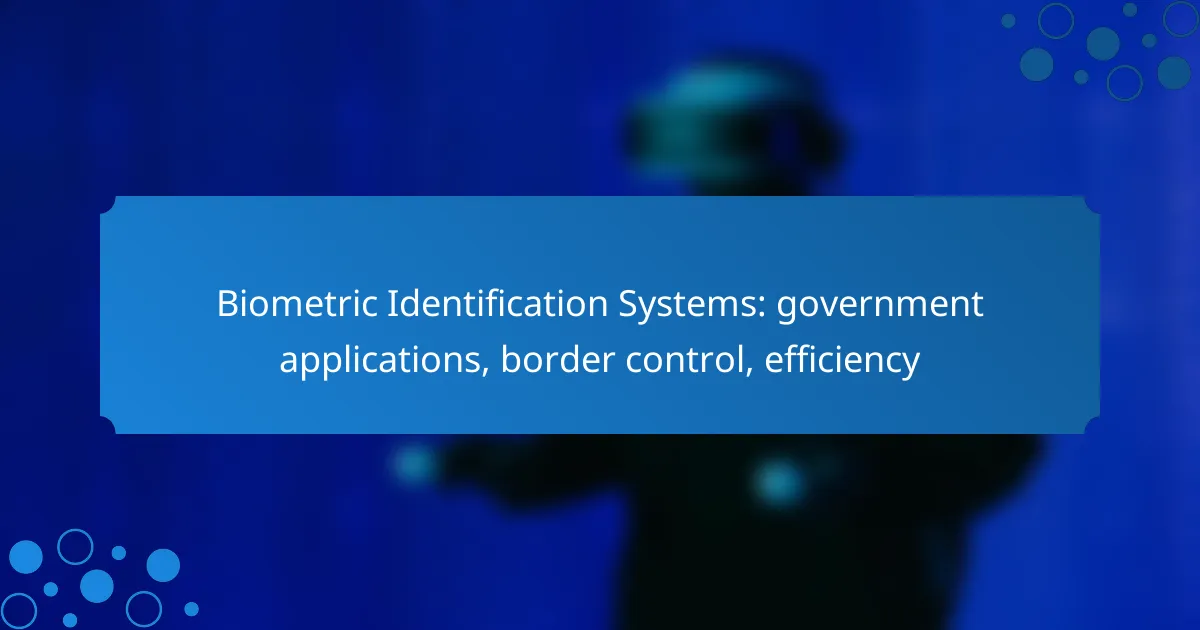Biometric identification systems are increasingly adopted by governments to enhance security and efficiency in public services, particularly in national ID programs and border control. By utilizing unique physical characteristics such as fingerprints and facial recognition, these systems enable faster and more accurate identification, streamlining processes and reducing wait times for travelers at entry points.
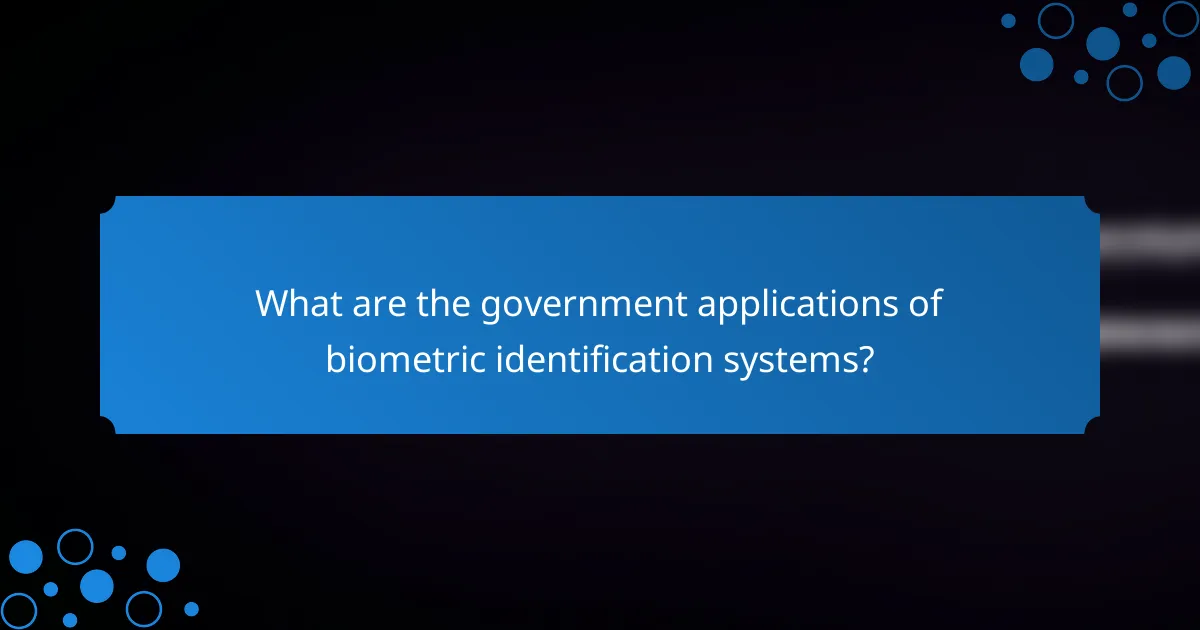
What are the government applications of biometric identification systems?
Biometric identification systems are increasingly utilized by governments for various applications, enhancing security and efficiency in public services. These systems leverage unique physical characteristics, such as fingerprints and facial recognition, to verify identities in critical areas like national ID programs and border control.
National ID programs
National ID programs often incorporate biometric identification to ensure accurate citizen identification and reduce fraud. By using biometric data, such as fingerprints or iris scans, governments can create secure and tamper-proof identification cards. This enhances the integrity of national databases and simplifies processes like voting and accessing services.
Countries like India with its Aadhaar program have successfully implemented biometric systems, registering hundreds of millions of citizens. Such programs can streamline government services but require robust data protection measures to safeguard personal information.
Voter registration verification
Biometric identification plays a crucial role in voter registration verification, helping to prevent electoral fraud. By confirming identities through biometric data, election authorities can ensure that only eligible voters participate in elections. This process typically involves capturing fingerprints or facial images during registration.
In many countries, biometric voter registration has led to increased voter confidence and participation. However, it is essential to maintain transparency and security in handling biometric data to avoid privacy concerns.
Criminal identification
Biometric systems are vital for criminal identification, aiding law enforcement in accurately identifying suspects and solving crimes. Fingerprint databases and facial recognition technologies allow police to quickly match biometric data from crime scenes with known offenders.
In the United States, the FBI maintains a comprehensive fingerprint database that assists in criminal investigations. While effective, the use of biometrics in law enforcement raises ethical questions about surveillance and data privacy that must be carefully addressed.
Social services access
Governments utilize biometric identification to streamline access to social services, ensuring that benefits reach the intended recipients. By verifying identities through biometric data, agencies can reduce fraud and improve service delivery efficiency.
For example, biometric systems in welfare programs can help confirm the identity of beneficiaries, making it easier to distribute aid. However, implementing these systems requires careful planning to address potential technical and privacy challenges.
Public safety initiatives
Biometric identification systems enhance public safety initiatives by enabling rapid identification of individuals in various contexts, such as airports and public events. These systems can quickly process large volumes of people, improving security measures and response times in emergencies.
Countries implementing biometric screening at borders and public venues have reported increased safety and efficiency. Nonetheless, it is crucial to balance security needs with civil liberties, ensuring that biometric data is used responsibly and ethically.
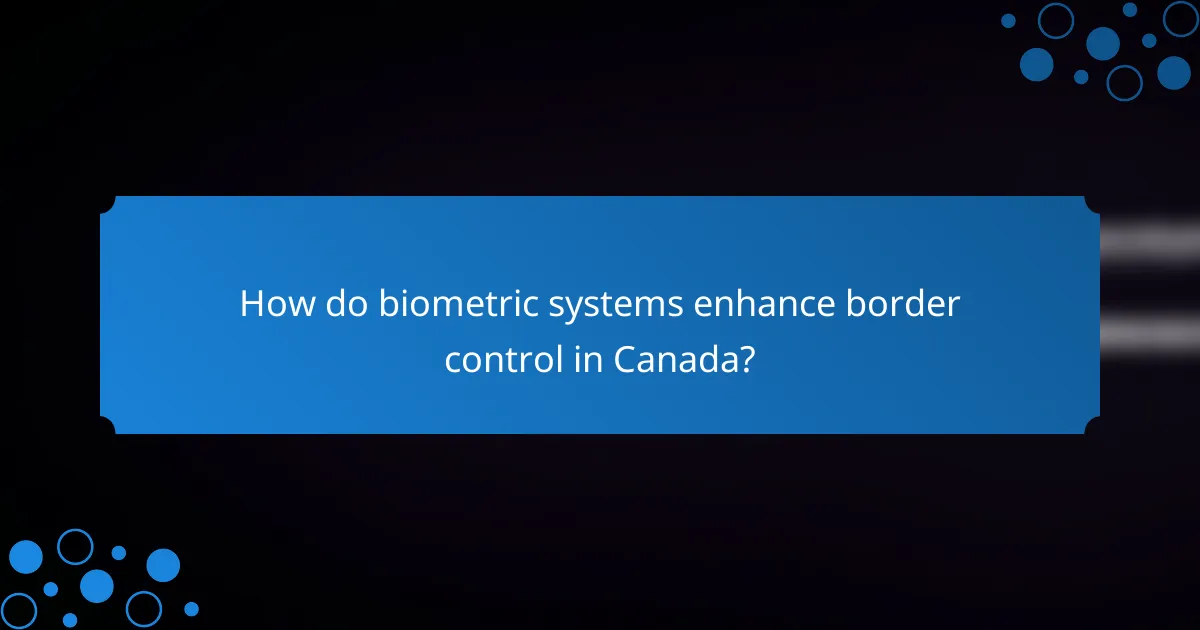
How do biometric systems enhance border control in Canada?
Biometric systems significantly improve border control in Canada by enabling faster and more accurate identification of individuals. These technologies streamline the processing of travelers, enhancing security while reducing wait times at entry points.
Facial recognition technology
Facial recognition technology captures and analyzes facial features to verify identities quickly. In Canada, this system is often deployed at airports and border crossings, allowing officials to match travelers’ faces against a database of known individuals, including watchlists.
While effective, this technology raises privacy concerns and requires adherence to regulations regarding data protection. Travelers should be aware that their images may be stored and used for future identification purposes.
Fingerprint scanning at checkpoints
Fingerprint scanning is another key biometric method used at Canadian border checkpoints. This technology captures unique fingerprint patterns to confirm identities, providing a reliable means of verification that is difficult to forge.
Travelers may encounter fingerprint scanners during entry and exit processes, which can significantly reduce processing times. However, individuals should ensure their fingerprints are registered correctly in the system to avoid complications.
Automated passport control
Automated passport control systems utilize biometric data, such as facial recognition and fingerprints, to expedite the passport verification process. In Canada, these kiosks allow travelers to scan their passports and complete identity checks without direct interaction with border agents.
This system enhances efficiency by allowing multiple travelers to process their entries simultaneously, reducing congestion at border points. However, travelers should ensure they understand how to use these kiosks to avoid delays.
Real-time identity verification
Real-time identity verification combines various biometric technologies to provide immediate confirmation of a traveler’s identity. This system is crucial in detecting fraudulent activities and ensuring that individuals crossing the border are who they claim to be.
By integrating facial recognition, fingerprint scanning, and database checks, Canada can maintain a high level of security while facilitating smoother travel experiences. Travelers should remain aware of the importance of accurate biometric data to prevent issues during border crossings.
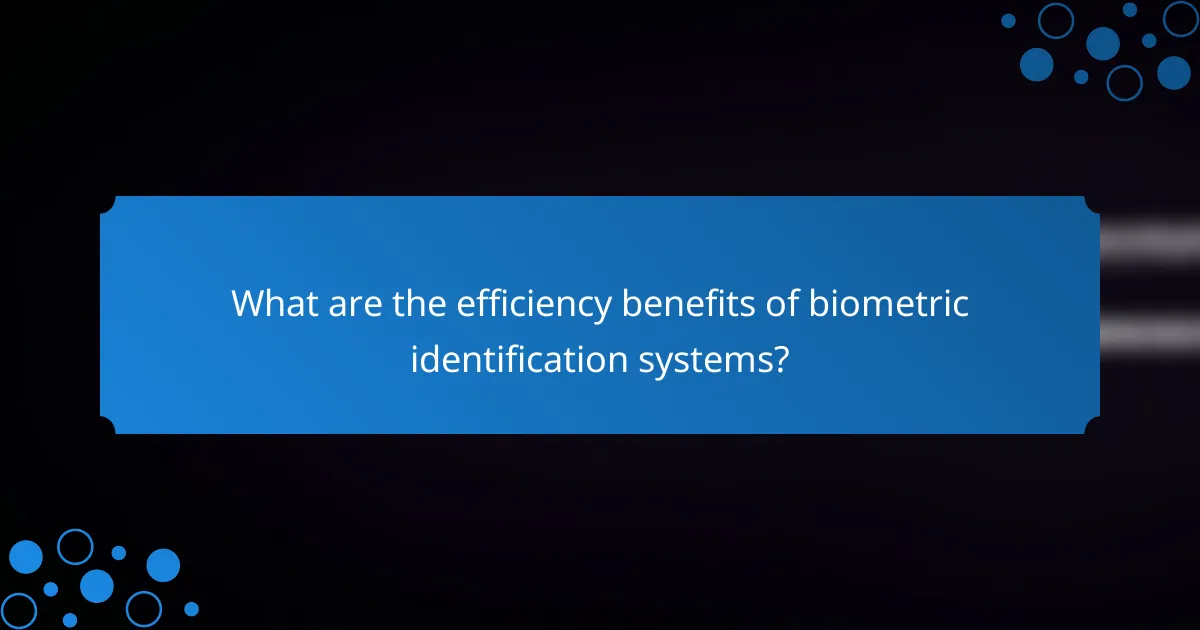
What are the efficiency benefits of biometric identification systems?
Biometric identification systems enhance efficiency in various applications, particularly in government and border control. These systems streamline processes, reduce errors, and improve overall service delivery.
Reduced processing times
Biometric systems significantly cut down the time required for identity verification. Traditional methods often involve manual checks that can take several minutes, while biometric scans typically complete in low tens of milliseconds. This rapid processing is crucial in high-traffic areas like airports and border crossings.
For instance, using fingerprint or facial recognition can allow travelers to clear security checks in seconds, minimizing wait times and improving throughput.
Increased accuracy in identity verification
Biometric identification systems offer a high level of accuracy, reducing the chances of identity fraud. Unlike traditional ID checks, which can be influenced by human error, biometric data is unique to each individual and difficult to replicate. This leads to a significant decrease in false positives and negatives.
For example, facial recognition technology can achieve accuracy rates exceeding 95%, making it a reliable option for government applications where security is paramount.
Lower operational costs
Implementing biometric systems can lead to lower operational costs over time. Although the initial investment may be substantial, the reduction in manual labor and error correction can offset these expenses. Organizations can save on staffing costs and resources dedicated to identity verification.
Additionally, the efficiency gained can lead to increased revenue opportunities, such as faster processing of travelers, which is particularly beneficial for airports and border control agencies.
Enhanced user experience
Biometric identification systems improve the user experience by providing a seamless and quick verification process. Users appreciate the convenience of not having to present physical identification multiple times, as biometric data is often stored securely and accessed quickly.
For example, travelers using biometric gates at airports enjoy a smoother journey, which can lead to higher satisfaction rates and repeat usage of services. This positive experience can enhance public perception of government agencies and their efficiency.
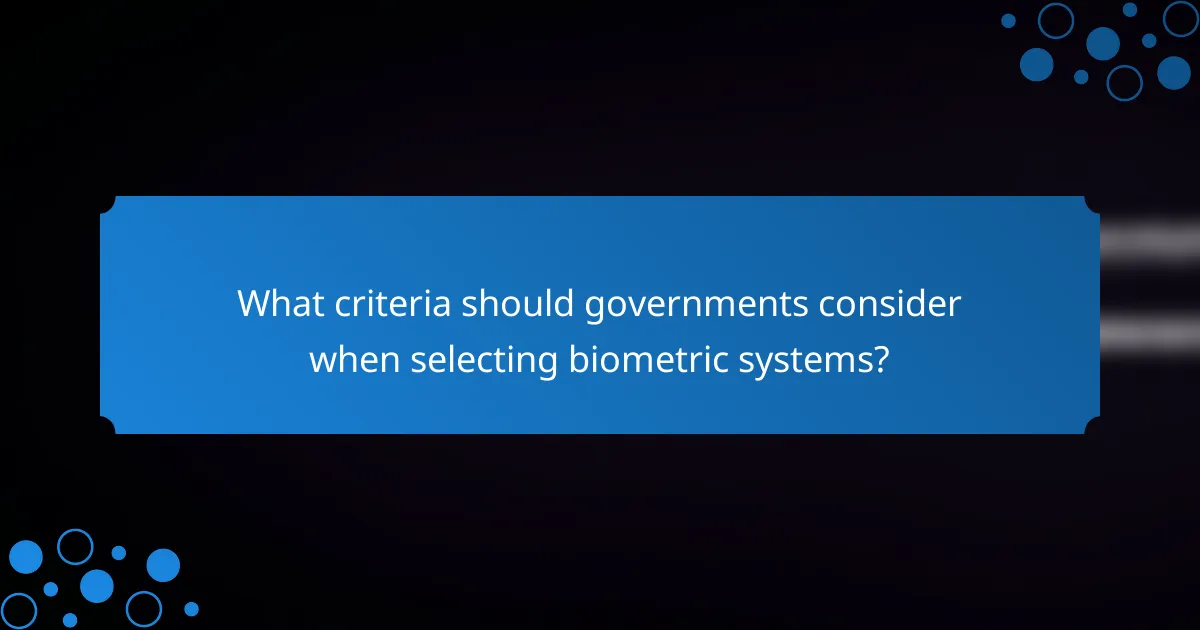
What criteria should governments consider when selecting biometric systems?
Governments should prioritize data security, integration capabilities, and scalability when selecting biometric identification systems. These factors ensure that the systems are not only effective but also secure and adaptable to future requirements.
Data security measures
Data security is crucial for protecting sensitive biometric information from unauthorized access and breaches. Governments should look for systems that employ strong encryption methods, secure storage solutions, and regular security audits to safeguard data integrity.
Additionally, compliance with international standards, such as ISO/IEC 27001 for information security management, can provide assurance that the biometric system meets high security benchmarks. Regular updates and patches are also essential to address emerging threats.
Integration capabilities with existing systems
Biometric systems must seamlessly integrate with current government databases and infrastructure to ensure efficient operations. Compatibility with existing identification systems, such as national ID databases or border control systems, can enhance functionality and reduce implementation costs.
Governments should assess whether the biometric solution supports standard protocols and APIs, facilitating smooth data exchange. A modular design can also allow for gradual integration, minimizing disruption during the transition.
Scalability for future needs
Scalability is vital for accommodating growing populations and evolving technological landscapes. Governments should consider systems that can easily expand to handle increased data volumes or additional biometric modalities, such as facial recognition or iris scanning.
Choosing a solution that allows for incremental upgrades and additional features can help future-proof investments. Regularly evaluating system performance and capacity will ensure that the biometric system remains effective as demands change over time.
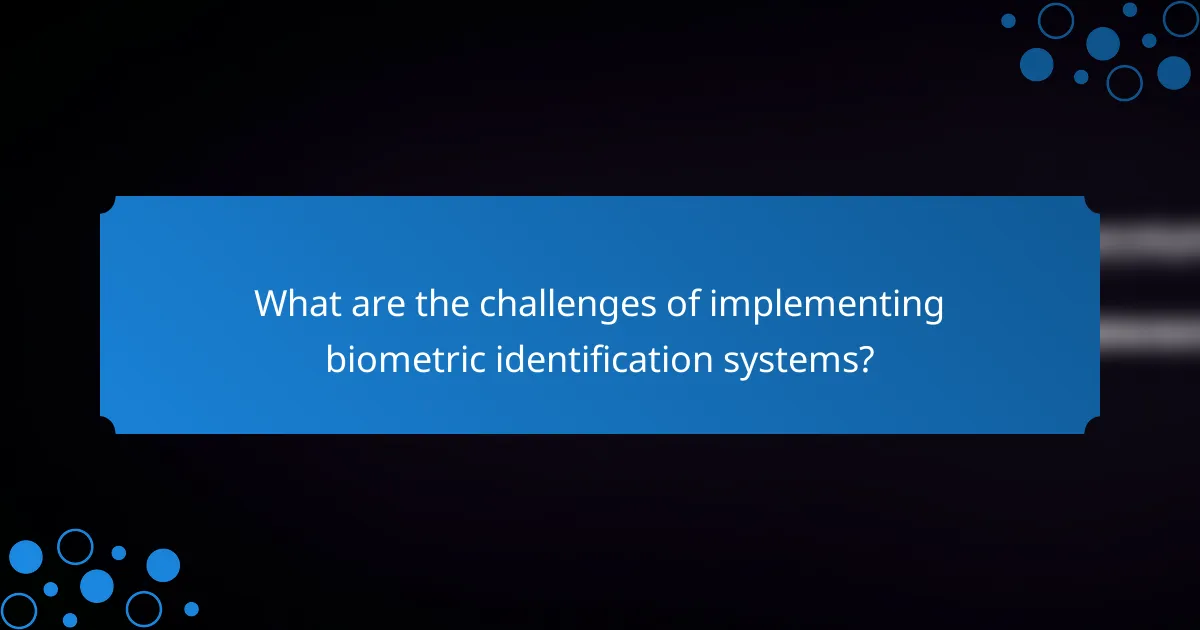
What are the challenges of implementing biometric identification systems?
Implementing biometric identification systems presents several challenges, including privacy concerns, technological limitations, and integration issues with existing systems. These obstacles can hinder the effectiveness and acceptance of biometric solutions in government applications and border control.
Privacy concerns
Privacy concerns are a significant challenge when implementing biometric identification systems. Citizens may fear that their biometric data, such as fingerprints or facial recognition data, could be misused or inadequately protected. Ensuring compliance with privacy regulations, such as the General Data Protection Regulation (GDPR) in Europe, is crucial for maintaining public trust.
Governments must establish clear policies on data collection, storage, and usage to address these concerns. Transparency about how biometric data is used and who has access to it can help alleviate fears and foster acceptance among the population.
Technological limitations
Technological limitations can impede the effectiveness of biometric identification systems. Factors such as environmental conditions, sensor quality, and user variability can affect the accuracy of biometric recognition. For example, facial recognition systems may struggle in low-light conditions or with individuals wearing masks.
To mitigate these limitations, governments should invest in high-quality biometric sensors and regularly update their systems to incorporate advancements in technology. Additionally, implementing multi-modal biometric systems, which use multiple types of biometric data, can enhance accuracy and reliability.
Integration with existing systems
Integrating biometric identification systems with existing government and border control systems can be complex and resource-intensive. Legacy systems may not support modern biometric technologies, leading to compatibility issues and increased costs. A comprehensive assessment of current infrastructure is essential before implementation.
Governments should prioritize a phased approach to integration, allowing for gradual updates and training of personnel. Collaborating with technology providers can also facilitate smoother transitions and ensure that new systems align with existing processes and regulations.
